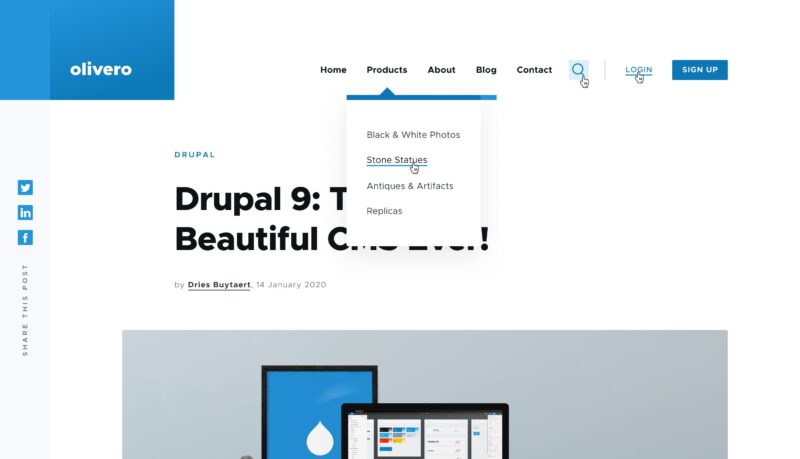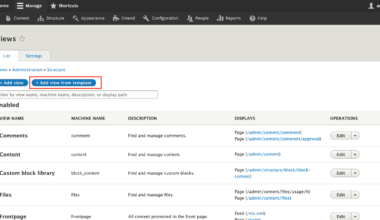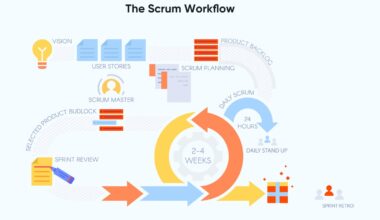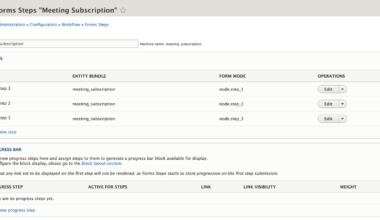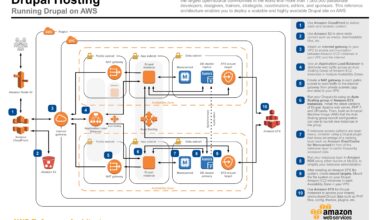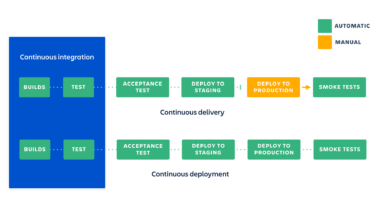Introduction: Understanding Drupal Theming and Design
As a content management system, Drupal provides a great foundation for building websites and web applications. One of the key features that makes Drupal stand out is its theming system, which allows developers and designers to create custom themes to change the look and feel of a Drupal site. In this article, we will explore best practices for Drupal theming and design to help you create effective and engaging websites.
When it comes to Drupal theming, there are two main components to consider: the theme itself and the design of the site. The theme is the code that controls the layout and functionality of the site, while the design refers to the visual elements such as colors, typography, and images. Both components are critical to creating a successful Drupal site.
To get started with Drupal theming, you will need to have a basic understanding of HTML, CSS, and JavaScript. Drupal uses a templating system called Twig, which is similar to other templating languages like Jinja and Django. You will also need to be familiar with Drupal’s file structure, including the use of .info.yml files, template files, and preprocess functions.
When it comes to Drupal design, it’s important to keep the end user in mind. Your design should be intuitive, easy to navigate, and visually appealing. This can be achieved through the use of white space, contrast, and other design principles.
Overall, Drupal theming and design can be challenging, but with the right tools and best practices, you can create beautiful and functional websites. In the following sections, we will explore some key best practices for Drupal theme development and design, as well as tips for customizing Drupal themes to fit your specific needs. Let’s get started!
Best Practices for Drupal Theme Development
Developing a Drupal theme can be an overwhelming task, but following best practices can make the process smoother and more efficient. Here are some key best practices to keep in mind when developing a Drupal theme:
1. Keep it simple: A simple and well-organized theme will be easier to maintain and update in the long run. Avoid using excessive code or complex design elements that could slow down your site’s performance.
2. Use a base theme: Starting with a base theme, such as Bootstrap or Zen, can save you time and effort. Base themes provide a solid foundation and can be easily customized to fit your specific needs.
3. Make it responsive: With the growing number of mobile users, it’s important to ensure that your theme is responsive and can adapt to different screen sizes. Use CSS media queries and flexible grids to create a responsive design.
4. Follow Drupal coding standards: Drupal has its own coding standards that are used to maintain consistency and readability throughout the codebase. Adhering to these standards will make your code easier to read and maintain.
5. Use preprocess functions: Preprocess functions allow you to modify variables before they are rendered in the template. This can be useful for adding custom classes or variables to the template.
6. Use template suggestions: Template suggestions allow you to create multiple versions of a template for different contexts. This can be useful for creating unique templates for specific pages or content types.
7. Test, test, test: Before launching your theme, it’s important to thoroughly test it for compatibility, accessibility, and performance. Use tools like Google Lighthouse and WAVE to check for any issues.
By following these best practices, you can create a well-designed and functional Drupal theme that meets the needs of your site and its users. Remember to keep it simple, responsive, and follow Drupal coding standards for a successful theme development process.
Tips for Creating Effective Drupal Designs
When creating a Drupal design, it’s important to focus on both the aesthetic appeal and functionality of the site. Here are some tips to keep in mind when designing a Drupal site:
1. Define your brand: Before starting the design process, it’s important to define your brand identity. This includes your brand colors, typography, and overall style. Use these elements consistently throughout the site for a cohesive look and feel.
2. Use color effectively: Color can be used to evoke emotions and create a specific mood. Use color theory to choose colors that complement each other and reflect your brand identity. Consider the accessibility of your color choices, and ensure that users with color blindness or low vision can still use the site.
3. Keep it simple: A cluttered design can be overwhelming and confusing for users. Keep the design simple and easy to navigate, with clear calls to action and a logical layout.
4. Use typography effectively: Typography plays a big role in the readability and overall feel of the site. Choose fonts that are easy to read and complement your brand identity. Use font sizes and weights strategically to create hierarchy and emphasize important information.
5. Consider accessibility: Accessibility should be considered throughout the design process. Use alt tags for images, provide captions for videos, and ensure that the site can be navigated using only a keyboard. Use high contrast between text and background colors to make the site easier to read.
6. Optimize images: Large images can slow down page load times, so it’s important to optimize images for the web. Use image compression tools to reduce file size without sacrificing quality.
7. Use responsive design: A responsive design is critical for ensuring that the site is accessible and usable on all devices. Use CSS media queries to adjust the layout and design based on screen size.
By following these tips, you can create a visually appealing and functional Drupal design that reflects your brand identity and meets the needs of your users. Remember to keep it simple, use color and typography effectively, consider accessibility, and optimize images for the web.
Customizing Drupal Themes for Your Website
Customizing a Drupal theme is a great way to make your website stand out and meet the specific needs of your business or organization. Here are some tips for customizing Drupal themes to fit your website:
1. Choose the right theme: Before customizing a theme, it’s important to choose the right one. Look for a theme that already has some of the features and functionality you need, as this will save you time and effort in the long run.
2. Customize the CSS: CSS is used to control the visual style of the website, including colors, fonts, and layout. Use CSS to customize the theme to match your brand identity and meet your specific design needs.
3. Use template overrides: Template overrides allow you to override the default template files with your own custom versions. This can be useful for making changes to specific elements of the website, such as the header or footer.
4. Use modules: Drupal has a vast library of modules that can be used to add functionality to your website. Look for modules that can help you achieve the specific features you need, such as a contact form or social media integration.
5. Create custom content types: Custom content types allow you to create unique types of content that aren’t available in the default Drupal installation. Use custom content types to create pages that meet the specific needs of your website.
6. Use views: Views allow you to create custom lists of content, such as blog posts or events. Use views to create custom layouts and displays of your content.
7. Test, test, test: As with any customization, it’s important to thoroughly test your website for compatibility, accessibility, and performance. Use tools like Google Lighthouse and WAVE to check for any issues.
By following these tips, you can create a customized Drupal theme that meets the specific needs of your website and reflects your brand identity. Remember to choose the right theme, customize the CSS and templates, use modules and custom content types, and thoroughly test your website for a successful customization process.
In conclusion, customizing a Drupal theme is a great way to make your website stand out and meet the specific needs of your business or organization. By following the best practices and tips outlined in this article, you can create a well-designed and functional Drupal site that meets the needs of your users. Don’t be afraid to experiment and try new things, and remember to continuously improve your Drupal themes and designs for
Final Thought: Continuously Improving Your Drupal Themes and Designs
Drupal theming and design are ongoing processes that require continuous improvement and updates. Here are some tips for continuously improving your Drupal themes and designs:
1. Stay up to date: Drupal is constantly evolving, with new releases and updates being released regularly. Stay up to date with the latest versions of Drupal and its modules to ensure that your site is secure, stable, and compatible with the latest technologies.
2. Analyze user feedback: User feedback is critical for improving your Drupal site. Use tools like Google Analytics to track user behavior and identify areas for improvement. Use feedback from users to inform your design decisions and make improvements to the site.
3. Conduct usability testing: Usability testing can help you identify any issues or problems with your site’s design and functionality. Conduct regular usability testing to ensure that your site is easy to use and meets the needs of your users.
4. Implement new design trends: Design trends are constantly evolving, and it’s important to stay up to date with the latest trends to keep your site looking fresh and modern. Implement new design trends as appropriate to keep your site up to date and engaging.
5. Experiment with new features: Drupal has a vast library of modules and features that can be used to enhance your site’s functionality. Experiment with new features and modules to see what works best for your site and its users.
6. Get feedback from peers: Getting feedback from other designers and developers can be valuable for improving your Drupal themes and designs. Join Drupal communities and forums to connect with others in the industry and get feedback on your work.
By continuously improving your Drupal themes and designs, you can ensure that your site remains relevant, engaging, and effective for your users. Remember to stay up to date, analyze user feedback, conduct usability testing, implement new design trends, experiment with new features, and get feedback from peers for a successful ongoing improvement process.
